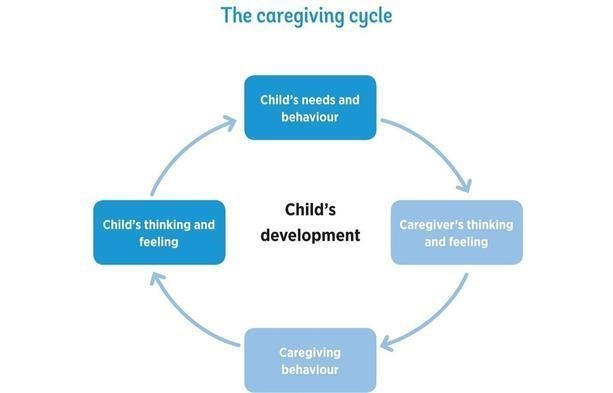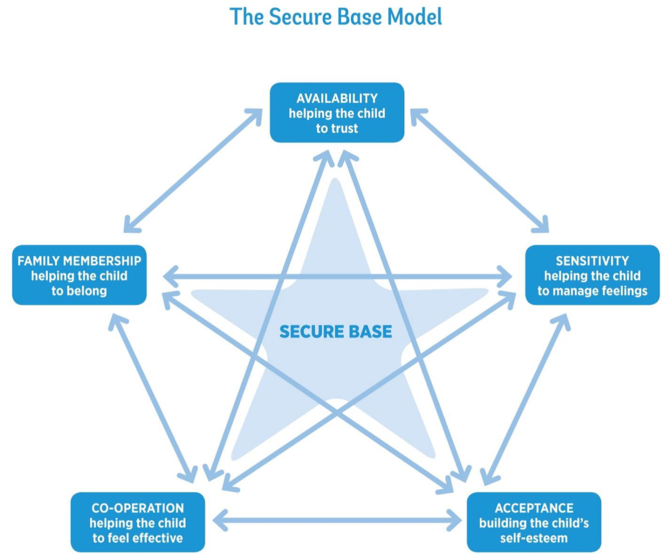Chapter contents
The Importance of a Secure Base
Understanding Children’s Behaviour
Information and Support to Foster Parents Around Behaviour
The Importance of a Secure Base
The Secure Base Model provides a positive framework that underpins our service at ISP. It is a shared vision, so our senior leadership team, managers, social workers and administrators have all received training in the secure base model, as well as our foster parents. Our aim is to improve the ordinary life experiences and chances of our children and young people.
A secure base is at the heart of any successful caring relationship – in birth families, foster care, residential care or adoption. It develops when the carer offers:
- a reliable base from which to explore and
- a safe haven for reassurance when there are difficulties.
A secure base promotes security, confidence, competence and resilience.
Understanding Children’s Behaviour
Many fostered children have had experiences that give them little reason to trust adults. They have developed behaviours based on a need to try to protect themselves and to control their relationships and environments. Warm, consistent and reliable caregiving can change children’s previous expectations, both of close adults and of themselves.
The Secure Base model provides a positive framework for therapeutic caring. It helps children and young people to move towards greater security and it builds resilience. It focuses on the interactions that occur between caregivers and children in the home, but it also considers how strong relationships at home can help the child to form healthy relationships in the outside world of school, peer group and community.
The caregiving cycle

The caregiving cycle begins with the child’s needs and behaviour and what their caregiver thinks and feels about the behaviour.
How a caregiver thinks and feels about a child’s needs and behaviour will determine how they respond to it. Their thoughts and feelings will have been influenced by experiences as well as what they have earned from training.
The caregiving behaviours that result convey certain messages to the child. These messages affect how the child thinks and feels about themselves and other people. This will have an impact – either positive or negative – on their development.
This process is represented in a circular model – the caregiving cycle. This shows the inter-connectedness of caregiver/child relationships, minds and behaviour, as well as their ongoing movement and change.
Information and Support to Foster Parents Around Behaviour
In order to provide a secure base for a child, you need information about the child’s past. This should include previously challenging behaviour, and advice about how to manage this behaviour. Your supervising social worker will chase up any information that has not been provided at the time of placement.
The child’s placement plan will set out any behavioural issues that you need to address, with suggested strategies to use.
Our ‘PRICE’ training course will help you to understand why the child is behaving in a challenging way. It also provides advice on managing difficult behaviour – including de-escalation techniques. Your supervising social worker will support you through regular supervision and support meetings to develop your skills and strengths. The team at your local ISP Centre is also on hand to offer support and guidance when you need it.
Complete the mandatory training course : PRICE (Protecting Rights in a Caring Environment)
See chapter 10 for more information about behaviour management.
Creating a Secure Base
Research tells us that it is of great importance for foster carers to recognise and build on the child’s strengths and abilities (their ‘resilience’). The Secure Base Model describes how you can create the best possible environment for a child:
Availability – Helping the child to trust
Sensitivity – Helping the child to manage feelings and behaviour
Acceptance – Building the child’s self-esteem
Co-operation – Helping the child to feel effective and to be co-operative
Family membership – Helping the child to belong

Availability – Approaches for helping children to build trust
- Establish predictable routines, e.g. around mealtimes and bedtimes
- Make sure the child knows where you are when you are not together
- Always be on time to collect them from school/social activities
- Make sure the child feels cared for and nurtured when unwell, hurt or upset
- Allow the child to take small items/photos from home to school
- Play games with the child, e.g. hand-clapping games, face painting, ball games, singing together, reading together
Sensitivity – approaches for helping children to manage feelings and behaviour
- Observe the child carefully; look for non-verbal signs of anxiety. This will help you to anticipate what will cause confusion or distress for the child and avoid it if necessary
- Show an interest in what the child has been doing, and how they have been feeling, when you have been apart
- Find time for one-to-one activity each day; try new experiences together and talk about it.
- Name and discuss feelings in everyday situations (happy, proud, sad, worried, excited, guilty, lonely, pleased). Discuss how feelings change over time
- Use sensory toys, e.g. ‘stress balls’, comforters, to help the child manage feelings
- Encourage children to stop and think before reacting. Use time-out techniques
Acceptance – approaches for building self esteem
- Praise the child for small tasks and responsibilities
- Play games that involve achievement
- Offer brief explanations of why behaviour is not acceptable, and a clear indication of what you would prefer, e.g. “if you shout it’s hard for me to hear what you want to say. I want to hear you, so please talk in an ordinary voice”
- Help the child to think about occasions when he has done something he is proud of
- Keep records of achievements and photos to look through with the child and remember
- Ask the child to teach you something you don’t know, but that he or she is good at, e.g. a computer game
- Use dolls, toys, games that reflect the child’s ethnic, religious and cultural background
- Celebrate the child’s religious and cultural festivals with him
Co-operation – approaches for helping children to feel effective – and be co-operative
- Let the child take photos at family events/holidays
- Encourage the child to help around the house and offer thanks
- Play co-operative games; allow time each day to play together
- Allow the child to help make choices, e.g. at the supermarket
- Involve the child in solving problems – one problem at a time
- Involve the child in helping to cook family meals/baking together
Family Membership – approaches for helping children to belong
- Adapt family routines where possible to accommodate the child’s norms and preferences. This will help them to feel at home.
- Have special places for the child in the home. This can include their place at the table, their own hook for their coat, a name plaque on their bedroom door or a mug with their name on.
- Allow them to personalise their bedroom, within reasonable limits
- Promote family mealtimes and activities
- Display photos of the child alongside photos of your own children/family members. Allow the child to display photos of their birth family and talk about their birth family with them
- Watch for possible pressure points e.g. Mother’s Day, Father’s Day, Christmas. Find ways of indicating (where appropriate) that it is OK to give cards to more than one parent or to choose one rather than the other at different times.
(Source: Providing a Secure Base, Gillian Schofield and Mary Beek, University of East Anglia, Norwich, UK)
Training opportunity: Secure Base



